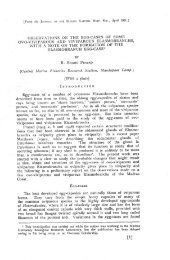PDF - Eprints@CMFRI
PDF - Eprints@CMFRI
PDF - Eprints@CMFRI
Create successful ePaper yourself
Turn your PDF publications into a flip-book with our unique Google optimized e-Paper software.
5<br />
Already in 1970 Dietrich D. KUEHLMA N of the Museum fUr Naturkunde in Berlin visited Massawa<br />
and Port Sudan to collect corals. This was followed in 1976 by a four-month stay at Al Hudayah and Port<br />
Sudan to study the dependence of coral associations on ecological factors. During that time KUEHLMANN<br />
also collected corals and dived down to 70 m at Wingate Reef. The coral collection has not been evaluated<br />
yet, but a few corals are dealt with in this report.<br />
Mention should be made of a large-scale coral collecting expedition to the Wingate Reef near Port<br />
Sudan and to the Island Djebel Zuqur in the south of the Red Sea in 1976, organized by the Meeresmuseum<br />
Stralsund and led by Sonnfried STREICHER, on MS "Eichsfeld", a merchant vessel of the German<br />
Democratic Republic. The course of the expedition " Acropora 76" was described by S. STREICHER<br />
("90 Tage im Roten Meer" ), its objectives ("Ein Riffturm soli es sein") and the corals ("Korallen") and<br />
coral reefs (" 1m Riff" ) were described by G. SCHULZE (all 1977). A comprehensive report of the expedition<br />
was published by S. STREICHER in his book "90 Tage im Korallenriff" (1980). In 1979 a second<br />
expedition "Acropora 79" was made to the island of Umm-al-Sciora off the Ethiopian harbour Assab<br />
with the purpose of collecting further material. An impressive coral reef was built and is on display at the<br />
Meeresmuseum Stralsund, whereas the vast coral collection hat not been evaluated so far. A general review<br />
of both expeditions was given by the Meeresmuseum Stralsund in 1981.<br />
Besides The Marine Biological Station at Ghardaqa in Egypt a second centre of marine research developed<br />
at the northern end of the Gulf of Aqaba. As early as 1936 scientists of the Hebrew University in<br />
Jerusalem started to study the Red Sea fauna. After the State of Israel was founded in 1948 it became<br />
necessary to make use of the nutritional resources of the Red Sea to supply the population with food. In<br />
1950 the town of Eilat was founded, whose harbour constantly increased in importance. The cooperation<br />
between the Department of Fisheries of the Government and the Universities of Jerusalem and Tel Aviv<br />
resulted in an intensive exploration of the litoral marine fauna of the Sinai Peninsula.<br />
This cooperation was highlighted by the two South Red Sea Expeditions of 1962 and 1965 to the<br />
region of the Dahlak Archipelago northeast of Massawa. o. H. OREN reported in 1962 on the first,<br />
C. LEWINSOH & L. FISHELSON in 1967 on the second expedition. A. WAINWRIGHT described in 1965<br />
the coral reef communities of the first expedition. Both expeditions brought home large coral collections<br />
which were identified by J . W. WELLS and M. PICHON, though not published. In 1968H. BOSCHMA wrote<br />
on "The Milleporina and Stylasterina of the Israel South Red Sea Expedition" and J. VERSEVELDT on<br />
Octocorallia (Stolonifera and Aleyonacea) in 1965.<br />
To provide a home for research and teaching a provisio nal marine biological station in tents and<br />
waggons was set up south of Eilat in the fifties, which was also open to scientists of other countries. In<br />
1965 /66 a first course on tropical marine biology for students and young scientists was organized by<br />
MAMBO (Mediterranean Association of Marine Biology and Oceanology). In 1968 an urgently needed<br />
modern research institute could be opened south of Eilat whose first director was Heinz STEINITZ.<br />
H. FENTON & H. STE INITZ wrote on Israel's marine biological research in 1967, the Marine Biological<br />
Laboratory was reported on in an anonymous paper of the Hebrew University of J erusalem in 1968, and<br />
in 1969 by G. v. WAHLERT and W. KLAUSEWITZ , one of the first foreign visitors (1968) to the new station.<br />
Shortly afterwards (i n May 1968) H. FEUSTEL of the Hessisches Landesmuseum Darmstadt went to Eilat<br />
and brought home from there a small collection of corals, which are mentioned in the present report.<br />
The " Hebrew University - Smithsonian Institution J oint Program" whose main objective was to study<br />
the " Lessepsian migration", the migration of organisms from the Red Sea into the Mediterranean through<br />
the Suez Canal, started in 1967 and lasted several years. The most important results, the story of the<br />
programme and the collecting tasks were described by F. D. POR , H. STE INITZ , J. FERB ER & W. ARO<br />
in 1972 . They also described the different habitats and marked them on maps, and indicated the registration<br />
numbers. In the course of this programme also corals were collected, mainly in the Gulf of Aqaba,<br />
but also in the Gulf of Suez and some in the Red Sea at the south tip of the Sinai Peninsula. Prof. Dr. POR<br />
sent us the corals for evaluation, however, a manuscript completed in 1974 (SCHEER & PILLAI) could<br />
not be published. These corals are therefore dealt with in the present report.<br />
From 1968 to 1971 the Tel Aviv University, too, collected corals along the coasts of the Sinai Peninsula<br />
in the Gulf of Aqaba and in the Gulf of Suez. These corals were sent to us for identification by Prof. Dr.<br />
FISHELSON. Some corals were also sent to Dr. PICHON who gave us his list of names. All these corals are<br />
part of the present report.
















